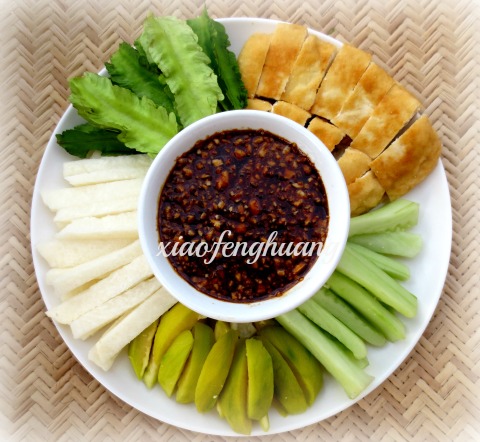Malaysian food cannot go without it. Guess what root vegetable is the most popular among us and our neighbours? Yam bean/sweet turnip is the most versatile root vegetable in Malaysia.
Its ID is Pachyrhizus Erosus. In English it is called sweet turnip, Chinese turnip, Mexican turnip, Jicama (pronounced hee-cama) or just yam bean. It is known as ubi sengkuang in Malay. In Chinese it is called Sha ge(沙葛) or Dou shu (豆薯)whereas local Chinese call it mangkuang (芒光).

According to Wikipedia and other sources from the net, yam bean is high in carbohydrates in the form of dietary or soluble fiber. It is composed of 86-90% water and contains only trace amount of protein and lipids. Its sweet flavor comes from the soluble fiber composed of oligofructose inulin which is a prebiotic, meaning it is a food for the good bacteria in the intestines. It is high in vitamin C, A and some Bs. It is high in potassium content. Because of its very low glycemic index, it is a great food for diabetics and its low calorie content makes it an ideal food for weight loss. By the way, GI measures how a carbohydrate-containing food raises blood sugar.

It is part of the legume family and grows on vines. This little-known tuber in the West is a very popular root vegetable in South East Asia, especially among the Malaysians, Thais, Indonesians and Vietnamese. Most often it is eaten raw but it can be juiced and used in stir-fried dishes.
Sengkuang tastes great when eaten raw. It is juicy, sweet and crunchy. It tastes great in stir-fry dishes too. I fry Mee hoon with shredded sengkuang. It is used in steamed sengkuang kueh. It is used as an ingredient for filling of popiah, Vietnamese rice paper rolls, Hakka choi ban/菜粄 (steamed rice dumplings) and ban pi/粄皮(steamed rice flour sheets). Sengkuang is needed in both Malaysian and Indian rojak. It can be included in salsa and Western salad.
In the picture above, it is used as filling of tofu pockets together with shredded carrots or half-ripe papaya, cucumber and sengkuang. Sprinkle some roasted sesame seeds on the sauce and filling. Serve the pockets with sweet and sour chilli sauce.
Prepare your own Tofu pockets by cutting fried tofu diagonally and then cut a slit at the center. Dig out some tofu (to be mixed with the filling) using a small spoon to enable easier stuffing of tofu pockets.

I had fond memories of these stuffed tofu way back in the Seventies when I studied in KL. I frequented a Malay stall in section 14 food center where a young man sold rojak and stuffed tofu. I always requested for more chilli sauce so often that he asked me whether I drank the sauce instead of dipping the tofu in the sauce.
The same recipe can be used in popiah/spring roll filling. However, for popiah filling you have to squeeze out some juice from the vegetable. A moist but not dry filling is ideal for the dish. Failing to do so will result in a soggy and messy popiah. No seasoning is needed for the filling so the chilli sauce provides the only flavor for the whole dish. Note that filling for this popiah is raw so it can be used as filling for Vietnamese rice paper rolls.

In the picture above, sengkuang is served with gado-gado sauce. This is a very popular dish well-loved by the Malaysians and Indonesians.
Recipe
Gado-gado(Indonesian Salad, Sarawakian style)
Ingredients
To prepare the gado-gado sauce
- 1/2 cup gula apong or gula melaka
- 1 tbs thick soy sauce
- 1/2 cup roasted groundnuts ( ground)
- 1 tsp chilli powder or 1 tbs chilli paste
- 6 limes – juice extracted
- 1 tsp assam paste (optional)
Serve the following food items with the sauce:
- 1 sengkuang – peeled and washed. Cut into thin wedges.
- 2 tofu or tempe – pan-fried, lightly browned and cut into bite size.
- 2 winged beans – eaten raw if they are home-grown
- 1 cucumber – cut into wedges
- 2 buah kedondong
Method
- Soften the gula apong over hot water for 10 minutes.
- Measure 1/2 cup of soften gula apong.
- Mix all the ingredients together.
- Dipping sauce for the cut vegetables and tofu is now ready !
Must try this dish. It is simple and delicious !

The picture above shows vegetable dumpling called “Choi ban” in Hakka. It is not easy to make this kueh. Need a lot of practice so recipe of this kueh will not be included here. The point I want to highlight here is its filling which is made of sengkuang and carrots stir-fried with slices of mushroom.

Same filling is used in steamed rice sheets. This rice sheet can be bought from local vendors or straight from the noodle factories. It can be in triangular shape or roll like a popiah.

Right – Gula Melaka
The picture shows the two types of palm sugar used frequently in Malaysian cooking. Join our facebook page to find out whether sourcing of these two types of sugar are possible.
Enjoy our local vegetable and dishes,
the ever popular sengkuang, popiah, rojak and gado-gado !
Copyright claim – Do not crop any pictures from malaysiavegetarianfood.com. Do not share our pictures without any watermarked signature on them. Excerpts from our articles to be credited to malaysiavegetarianfood.com.
